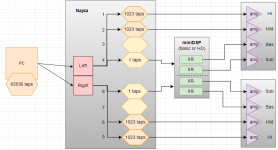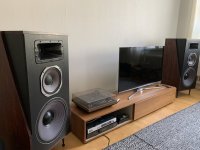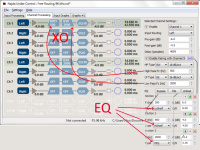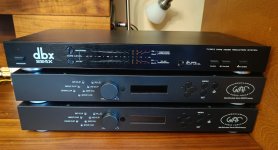I vaguely recall that the application Najda Under Control (NUC) was written by a third party. Does anyone have reliable information regarding this? If correct, that person might have pertinent information to share.
Try to find some persons from Wroclaw Audio Force/WAF, they probably can know more, if WAF was not drive by Nick alone.
Reset NAJDA !
Hi all,
I found out how to reset the board: This can be very helpful !
This is how it is: Load and run the OLD NUC 1.1.1 (It's available in the DIY audio forum)
Then the Najda complains that it can't start because the software is too old.
Then it independently loads new drivers and software for the processor, which it then resets.
Then everything is back to square one, but it works again !!!
Because if you treat the Najda correctly - all FIR with only 48 kHz, L/R 48 dB, lower separation > 200 Hz !,
Mids and highs correctly equalized (RePhase auto), bass only roughly by hand, also with RePhase,
Swap the OPAmps for Burr-Brown OPAmps, swap all coupling capacitors for MKPs,
and then a clever, regulated, linear power supply
- then it sounds really great !
Rainair
Hi all,
I found out how to reset the board: This can be very helpful !
This is how it is: Load and run the OLD NUC 1.1.1 (It's available in the DIY audio forum)
Then the Najda complains that it can't start because the software is too old.
Then it independently loads new drivers and software for the processor, which it then resets.
Then everything is back to square one, but it works again !!!
Because if you treat the Najda correctly - all FIR with only 48 kHz, L/R 48 dB, lower separation > 200 Hz !,
Mids and highs correctly equalized (RePhase auto), bass only roughly by hand, also with RePhase,
Swap the OPAmps for Burr-Brown OPAmps, swap all coupling capacitors for MKPs,
and then a clever, regulated, linear power supply
- then it sounds really great !
Rainair
Last edited:
That's brilliant.I found out how to reset the board: This can be very helpful !
I've filled that info away.
Never know when it might be needed.
Remember that my friend spoke with Nick on the phone some year ago and he told me that it was some software developer from Poland. I will ask him if he recalls more. Maybe his sister Sophie Holzem has some insight who he was working with? From what I remember she has Facebook account.I vaguely recall that the application Najda Under Control (NUC) was written by a third party. Does anyone have reliable information regarding this?
bass only roughly by hand, also with RePhase,
1023 taps don't seem to be enough to do anything of value below 200Hz. Or do you want to explain what you are doing?
I have also used FIR for mid- and high- speakers. The taps are not enough at the mid-low end 200Hz, but I have been able to manage some XO features. However, the horn offers many adjustable opportunities.
See the picture of how I solved the lack of taps at the low end.
Attachments
I never thought of that option. Being old school I use 18dB/oct Bessels and let Najda process at 96kHz, I also favor linear supplies, but haven't dared to apply tweaks to the PCB. I really need to add some room correction for the subs, but haven't come to make any sweep measurements yet. As is I'm very content currently listening to the Simply Red, Picture Book LP.I have also used FIR for mid- and high- speakers
I have tried to tune my subs using the Multi-Sub Optimizer. You measure your subs separately in, say, three locations. Then, MSO will give you parameters to feed into the miniDSP or processor that you have. My old miniDSP cannot delete the signal long enough for me to get the best result. So, I would recommend getting the miniDSP HD that can do more.
Here is a very good MSO Tutorial using REW and MiniDSP HD. But you really need to make some effort to learn to do it. It is not difficult, but there are lots of options to improve the end result.
Here is the MiniDSP page that presents different ways to do multi-sub setups with also other software.
My JBL 2235 15" drivers are so good that I could not make any gain in the base register by having separate subwoofers in the room. So I sold them.
Ultimately, I measured both base drivers together as a mono speaker and EQed them as one driver. Music in the low register is basically mono, so I don't think that the R/L speakers need to be EQed separately. You can argue that this is not true, say, at 150Hz, where the base driver will also play but is no longer all mono. However, the benefit of this approach was that it was much easier to find an EQ that would produce an excellent bass response.
If you want to measure your response easily, then MMM is very nice.
Tuning Your System with a House Curve and Moving Mic Methods
Here is a very good MSO Tutorial using REW and MiniDSP HD. But you really need to make some effort to learn to do it. It is not difficult, but there are lots of options to improve the end result.
Here is the MiniDSP page that presents different ways to do multi-sub setups with also other software.
My JBL 2235 15" drivers are so good that I could not make any gain in the base register by having separate subwoofers in the room. So I sold them.
Ultimately, I measured both base drivers together as a mono speaker and EQed them as one driver. Music in the low register is basically mono, so I don't think that the R/L speakers need to be EQed separately. You can argue that this is not true, say, at 150Hz, where the base driver will also play but is no longer all mono. However, the benefit of this approach was that it was much easier to find an EQ that would produce an excellent bass response.
If you want to measure your response easily, then MMM is very nice.
Tuning Your System with a House Curve and Moving Mic Methods
I used to set my system up with measuring mic at the listening position. Sweeps for each of the 5 ways and then align for best phase coherency.
With my now Multi Entry Horn system I sort it with the measuring mic at 1m distance from the mouth (with acoustic absorbing material either side and top / bottom).
This then gives the best coherent sound from any position in the room.
Also works in different rooms and distances.
I guess the difference is in the single point source of the MEH (drivers in the 50Hz to 18KHz range all within 1/4 wavelength of each other), and focus of the narrower control pattern compared to large distances between each driver of the 5way and their wide dispersion, Exponential, Tractrix and le Cléach.
With my now Multi Entry Horn system I sort it with the measuring mic at 1m distance from the mouth (with acoustic absorbing material either side and top / bottom).
This then gives the best coherent sound from any position in the room.
Also works in different rooms and distances.
I guess the difference is in the single point source of the MEH (drivers in the 50Hz to 18KHz range all within 1/4 wavelength of each other), and focus of the narrower control pattern compared to large distances between each driver of the 5way and their wide dispersion, Exponential, Tractrix and le Cléach.
I can only imagine how this sounds. I've seen pictures of Your system elsewhere, it looks just great. Myself I only have a backloaded horn together with a separate treble driver and a closed box for the lowest frequencies. The system with ear adjusted Najda x-over sounds fabulous to me. I also have a separate ESL57 system that I listen to occasionally. They sound fantastic in their own way but no way as full at the horn systemWith my now Multi Entry Horn system
(Sorry for maybe becoming a little too far off topic)
I went through a lot of pages here, was there ever a DSP XO released? I'm looking for a good and cheap DSP XO for active speakers.
Paul
Paul
Hi, the Najda project is regretfully defunct. With a little luck you can find a second hand unit, but don't expect support. Maybe the commercial MiniDSP suites your needs. If you want something more open and, depending on your own effort, less costly the CamillaDSP project would be something to trygood and cheap DSP XO
Last edited:
Of course as boards and as boxed product. Unfortunately Nick, the creator, got missing somewhere in south america some years ago.was there ever a DSP XO released
I guess unique feature of Najda is good quality analog domain multichannel attenuation. But as alugner wrote, only second hand units. My first was board bought "first hand" and second was boxed unit bought second hand.
Najda is a DSP processor that has both XO and EQ features. XO or EQ, technically, there is no difference. The XO is set for each driver at the high and low end of the frequency range where you want them to play. The EQ filters are then set between the XO filters.I'm looking for a good and cheap DSP XO for active speakers.
Attachments
Just found and bought another boxed Najda unit. This time with usb audio card. Should have it home in few days. I'm still hoping for one with additional IO/balanced card.
I've got a spare Najda with the balanced install.I'm still hoping for one with additional IO/balanced card.
I'm never going to use that option🙂
I2S over HDMI to Najda
I use a Gustard U18 reclocker (cleans up Sonore Ultrarendu Streamer nicely).
Was using RCA SPdif to connect up.
Prior to this I was using RPi/Kali reclocker with Volumio, I2S in to Najda.
Before that USB with WaveIO I2S in.
I wanted to be able to use a CD transport sometimes with SPdif.
Found the CDES I2S over HDMI to Native I2S converter module, cheap on AliExpress.
Got got around to wiring it up.
Removed RPi/Kali.
Figured out the pins
G D B L M on the CDES module
Ground, Data, BCK, LRCK , MCK
Najda has the following.
Line1 (audio data pair) pin 1
I2S Serial Clock Receive (CKR) pin 23
I2S Frame Sync Receive (FSR) pin 25
I2S External Master Clock Receive (Ext_CLK) pin 27
And a digital ground for each (connected then all together).
Gave it +5V from pin 28.
Connected up, powered up.
Plays perfectly.
Quick lash up to see if it worked


Result! SPdif freed up.
Najda 👍 - still as good as ever
I use a Gustard U18 reclocker (cleans up Sonore Ultrarendu Streamer nicely).
Was using RCA SPdif to connect up.
Prior to this I was using RPi/Kali reclocker with Volumio, I2S in to Najda.
Before that USB with WaveIO I2S in.
I wanted to be able to use a CD transport sometimes with SPdif.
Found the CDES I2S over HDMI to Native I2S converter module, cheap on AliExpress.
Got got around to wiring it up.
Removed RPi/Kali.
Figured out the pins
G D B L M on the CDES module
Ground, Data, BCK, LRCK , MCK
Najda has the following.
Line1 (audio data pair) pin 1
I2S Serial Clock Receive (CKR) pin 23
I2S Frame Sync Receive (FSR) pin 25
I2S External Master Clock Receive (Ext_CLK) pin 27
And a digital ground for each (connected then all together).
Gave it +5V from pin 28.
Connected up, powered up.
Plays perfectly.
Quick lash up to see if it worked
Result! SPdif freed up.
Najda 👍 - still as good as ever
- Home
- Source & Line
- Digital Line Level
- DSP Xover project (part 2)




